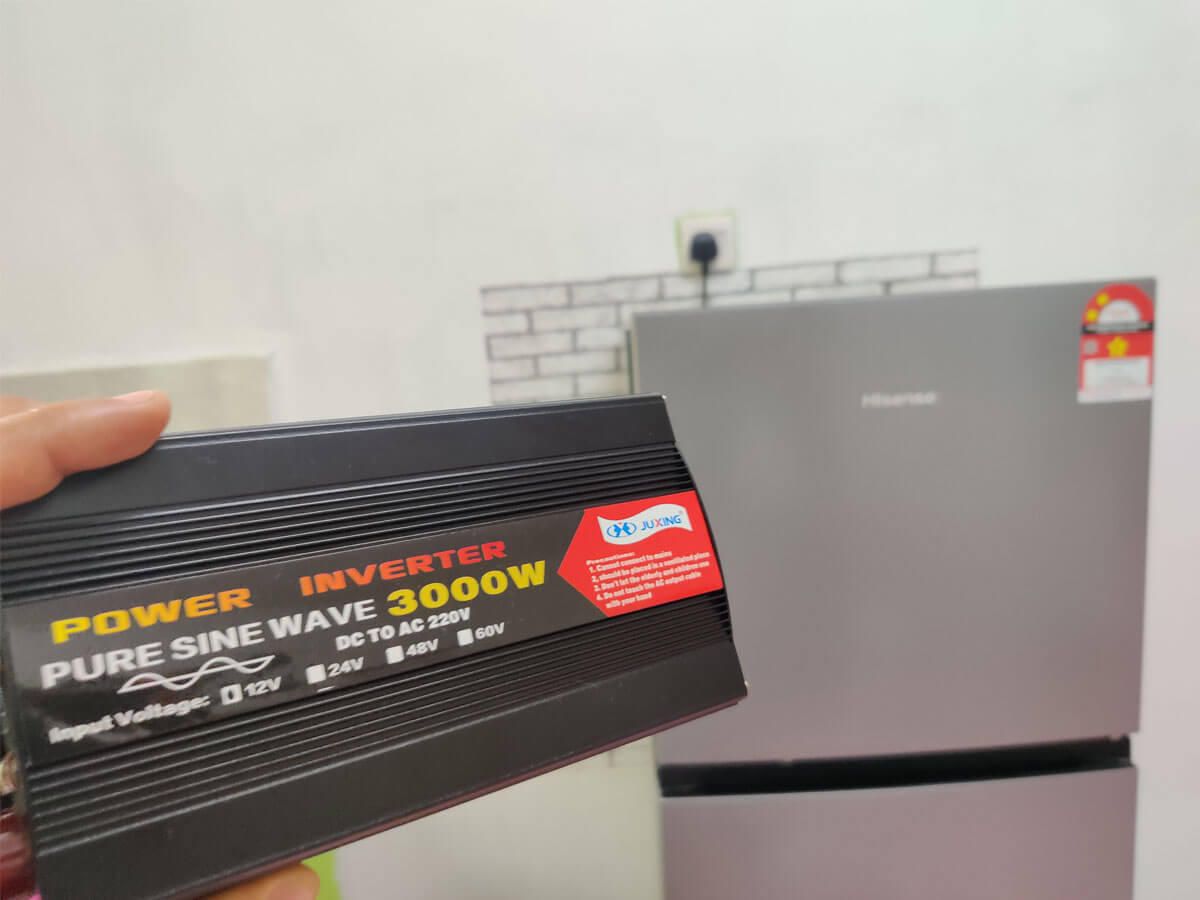
You could run most refrigerators using a 1500-watt pure sine wave inverter. Inverters of this size and type can consistently supply 1500 Watts of smooth AC power and can handle up to 3000 Watts for a brief moment if needed.
However, depending on factors like the size, age, and power usage of your refrigerator, you might find a larger inverter necessary, or a smaller one might do the trick.
For example, in my case, I didn’t need a 1500-watt inverter to run my 7 Cu. ft. refrigerator, and was able to run it on a 12V battery using a 500 Watt inverter:
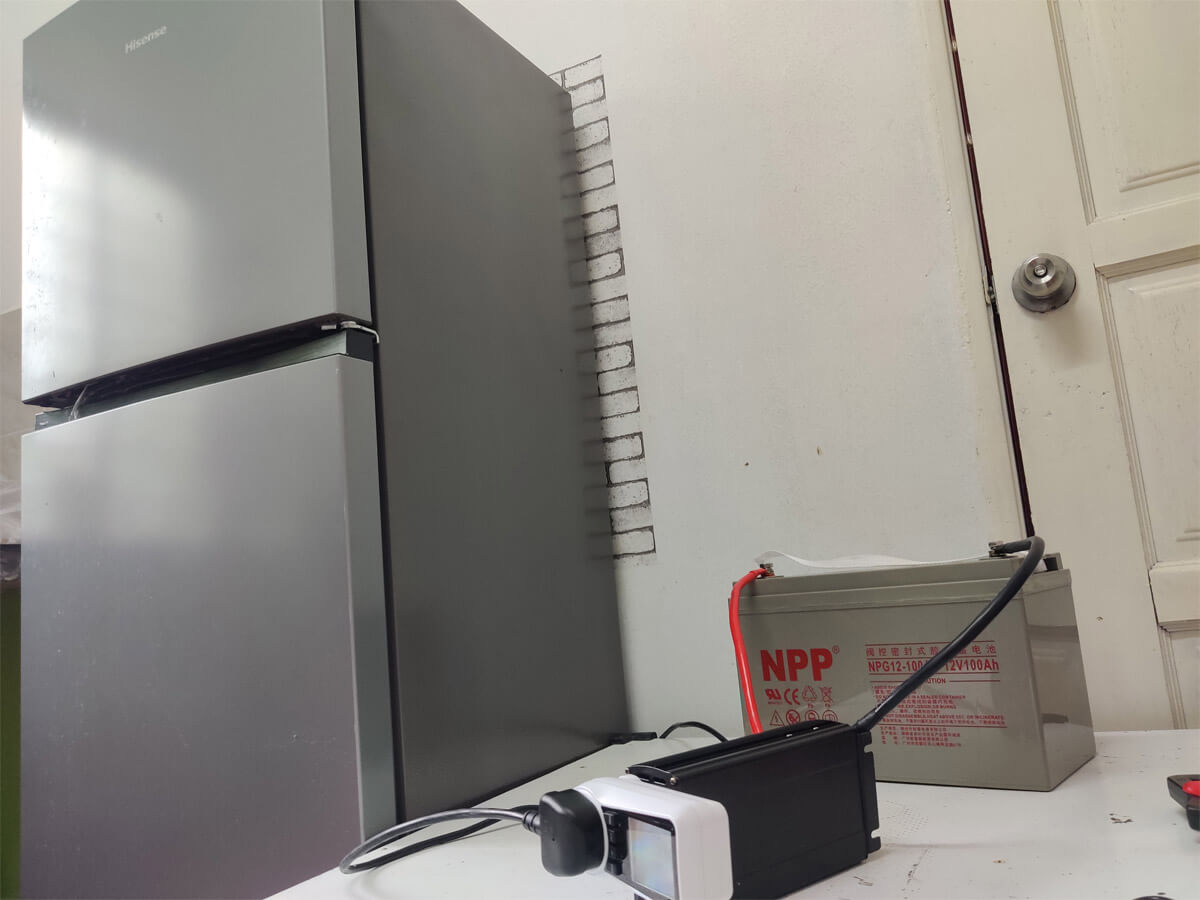
So, to give you a starting point and some perspective, here’s a table that categorizes refrigerators by their size or capacity, outlines their typical power usage, and estimates the Wattage rating of the inverter needed to run each:
| Capacity (Cubic feet or Liters) | Power Usage (Watts) | Inverter Power Rating (Watts) | |
| Continuous Power Rating | Surge Power Rating | ||
| 4 ft 3 (115 L) | 80 Watts | 300 Watts | 600 Watts |
| 7 ft 3 (200 L) | 150 Watts | 500 Watts | 1000 Watts |
| 10 ft 3 (280 L) | 200 Watts | 750 Watts | 1500 Watts |
| 14 ft 3 (400 L) | 250 Watts | 1000 Watts | 2000 Watts |
| 20 ft 3 (560 L) | 350 Watts | 1500 Watts | 3000 Watts |
| 25 ft 3 (700 L) | 450 Watts | 2000 Watts | 4000 Watts |
These estimates should give you a pretty good idea of the inverter size you need, but I still recommend checking your specific refrigerator’s specifications before buying an inverter.
Besides, when it comes to sizing an inverter, there are additional technical details that you need to consider other than just Wattage.
In this article, I’ll get into those details and guide you on checking your fridge’s electrical specs to make sure you pick the right inverter.
And if you’re more of a visual learner, I’ve made a video explaining it all. Check it out if you like:
I get commissions for purchases made through links in this post.
What are the inverter specifications to consider when sizing one for your refrigerator?
In general, off-grid inverters have 4 main ratings that characterize them and that you should pay attention to:
- The Continuous Power of the inverter, rated in Watts (W).
- The Surge Power of the inverter, rated in Watts (W).
- The Input Voltage of the inverter, rated in Volts (V).
- The Output Waveform of the inverter.
Now, let’s break down what each of these ratings represents.
Continuous Power (Watts):
The Continuous Power (Watts) rating of the inverter is its most important feature. It represents the amount of Electrical Power (in Watts) that the inverter is designed to continuously deliver at its output.
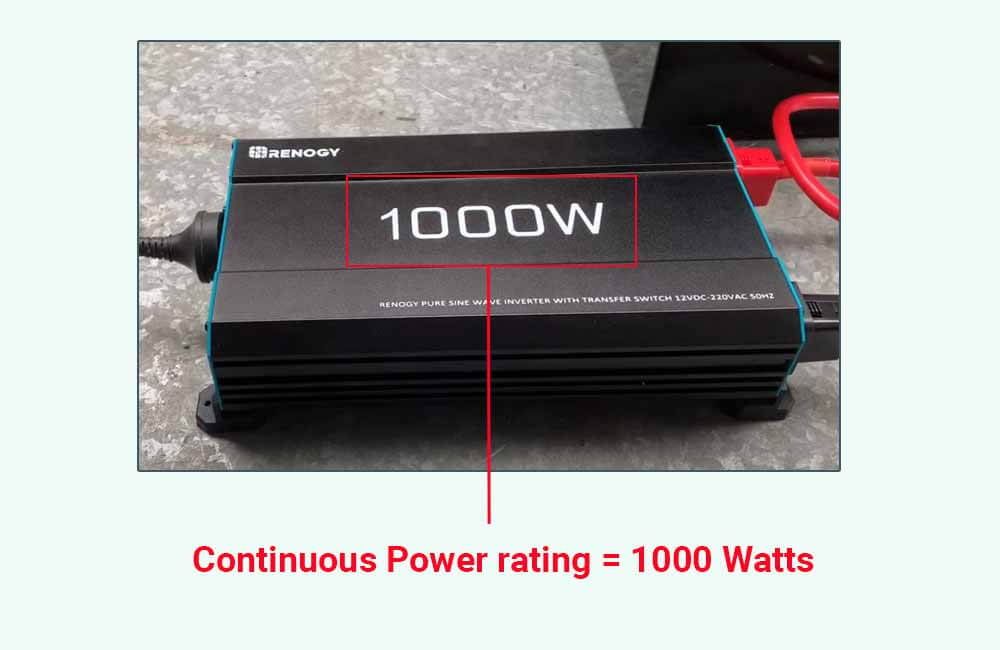
When an inverter is rated at a specific Wattage, it typically refers to its Continuous Power Rating. For instance, this Renogy inverter is rated at 1000 Watts, indicating it’s designed to consistently output up to 1000 Watts of power.
A key factor in sizing an inverter is ensuring that its Continuous Power rating is always higher than the combined Power Usage (Wattage) of the appliances it’s meant to run simultaneously.
For instance, if your fridge is the sole appliance connected to the inverter, the inverter’s Continuous Power rating should exceed the Power Usage (Wattage) of your refrigerator. We’ll dive deeper into this in the next section.
Surge Power (Watts):
The Surge Power (Watts) rating of an inverter represents the maximum amount of overloading power it can handle for a very short period (up to a few seconds).
The Surge Power rating of an inverter is typically 2 times its Continuous Power rating. For example, If we look at this 1000W inverter, we can see that the manufacturer specifies 2000W as its Surge Power rating.
This rating becomes especially important when the inverter is powering appliances with motors, such as refrigerators, freezers, air conditioners, washers, or pumps. This is because the motors within these appliances can demand a high amount of power (Watts) briefly during startup.
Even though this surge in power usage is brief, it’s generally at least twice the normal running wattage of the appliance and can sometimes reach up to 6 times that running wattage.
For example, a refrigerator needing only 200 Watts during normal operation might momentarily require up to 1200 Watts when the compressor starts up.
In any case, the Surge Power rating of the inverter should exceed the surge power requirements of the appliance, or else, the appliance, like a fridge, might fail to start.
Input Voltage (Volts):
Inverters not only turn DC (Direct Current) power to AC (Alternating Current) power but also convert the low voltage (12, 24, or 48 Volts) supplied by the batteries into a higher voltage (120 or 240 volts) required by the refrigerator.
Typically, inverters come with a specified Input Voltage range (VDC). For example, this 12V Renogy inverter will only function within a battery voltage range of 10 to 16 Volts, making it incompatible with a 24V or a 48V battery bank.
Conversely, this 1200W Giandel inverter, rated for 24VDC, operates within a battery voltage range of 19 to 32 Volts. Consequently, it’s not compatible with a 12V or a 48V system.
So, when sizing an inverter for your refrigerator, make sure the Input Voltage that it’s rated for is compatible with the nominal voltage of your battery bank.
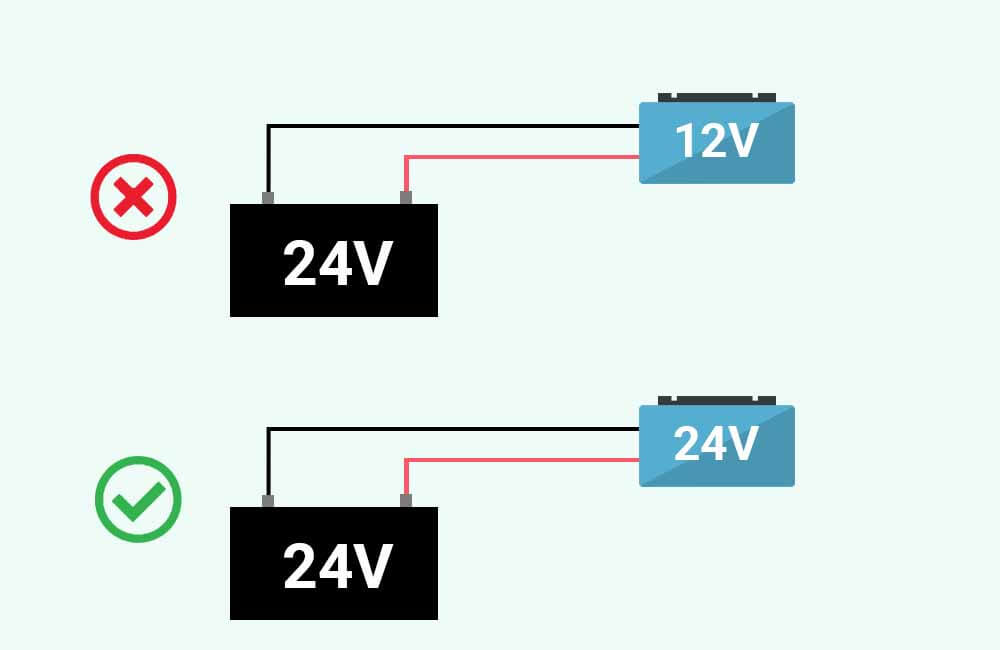
If you haven’t determined the appropriate size for the battery bank capable of powering your refrigerator, you can find more information on the topic here.
The Output Waveform:
Inverters convert DC (Direct Current) Power into AC (Alternating Current) Power. Essentially, they take the steady voltage and current supplied by a DC source, like a battery bank, and transform it into an alternating voltage and current suitable for appliances such as refrigerators.
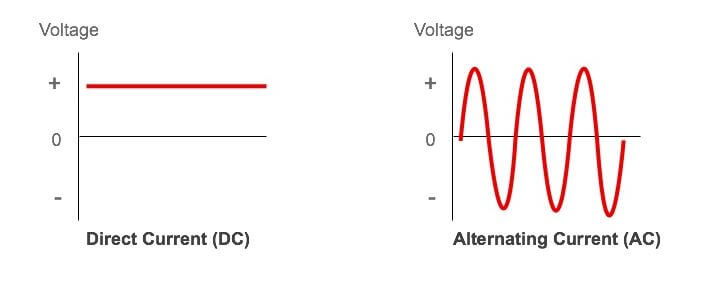
However, the kind of AC signal your inverter produces depends on the type of inverter you’ll be using.
There are two common types:
- Pure Sine Wave (PSW) inverters
- Modified Sine Wave (MSW) inverters
Pure Sine Wave (PSW) inverters are more expensive but will provide a smooth and frictionless AC waveform, similar to what is supplied by the utility grid. A Modified Sine Wave (MSW) will cost less, but will output an AC waveform that looks more like a square wave:
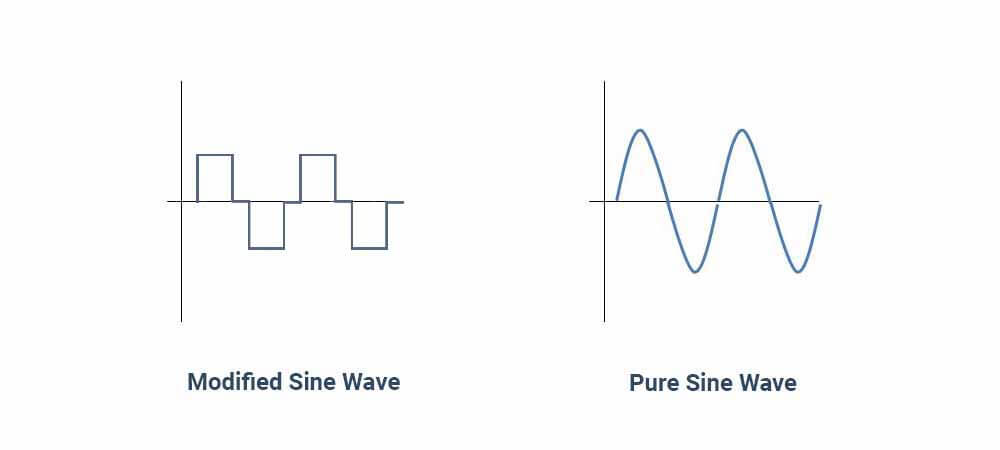
Your refrigerator can run on either of these inverter technologies. However, it’s worth noting that using a Modified Sine Wave (MSW) inverter might potentially shorten the lifespan of the fridge and lead to higher energy consumption.
So, if you aim to build an energy-efficient setup and prevent any potential harm to your refrigerator, it’s recommended to opt for a Pure Sine Wave inverter.
Now that we’ve covered what to consider in an inverter, let’s turn our attention to what to look at in your refrigerator.
What size inverter do I need to run a refrigerator?
Let’s assume the inverter already satisfies the following criteria:
- Its Input Voltage rating matches the nominal voltage of your battery bank (12V/24V/48V).
- Its Output Voltage rating matches the Rated Voltage of your refrigerator (120V/240V).
- It’s a Pure Sine Wave inverter.
However, for the inverter to reliably power your refrigerator, it still needs to meet the following conditions:
- Have a Continuous Power rating that is greater than the Rated Power (Wattage) of your refrigerator.
- Have a Surge Power rating that is greater than the “Potential Surge Wattage” of your refrigerator.
Let’s first discuss the Rated Power of your refrigerator.
What is the Rated Power of your refrigerator?
The Rated Power of your refrigerator represents the maximum amount of electrical power (in Watts) that the fridge may use for an extended period. The inverter you choose should be capable of continuously providing this amount of power.
The Rated Power of a refrigerator can vary based on factors like size, age, and efficiency. You can find this information in the user manual or on the electrical specifications label/sticker that comes with the refrigerator.
To figure out the continuous power usage of your refrigerator, locate the Rated Voltage (in Volts) and the Rated Current (in Amps) specified by the manufacturer, and multiply them:
Rated Power (Watts) = Rated Voltage (Volts) x Rated Current (Amps)
As mentioned earlier, you can find these specifications on the electrical specifications label, usually located on the side or inside the fridge.
For instance, let’s refer to the specification label inside my refrigerator:
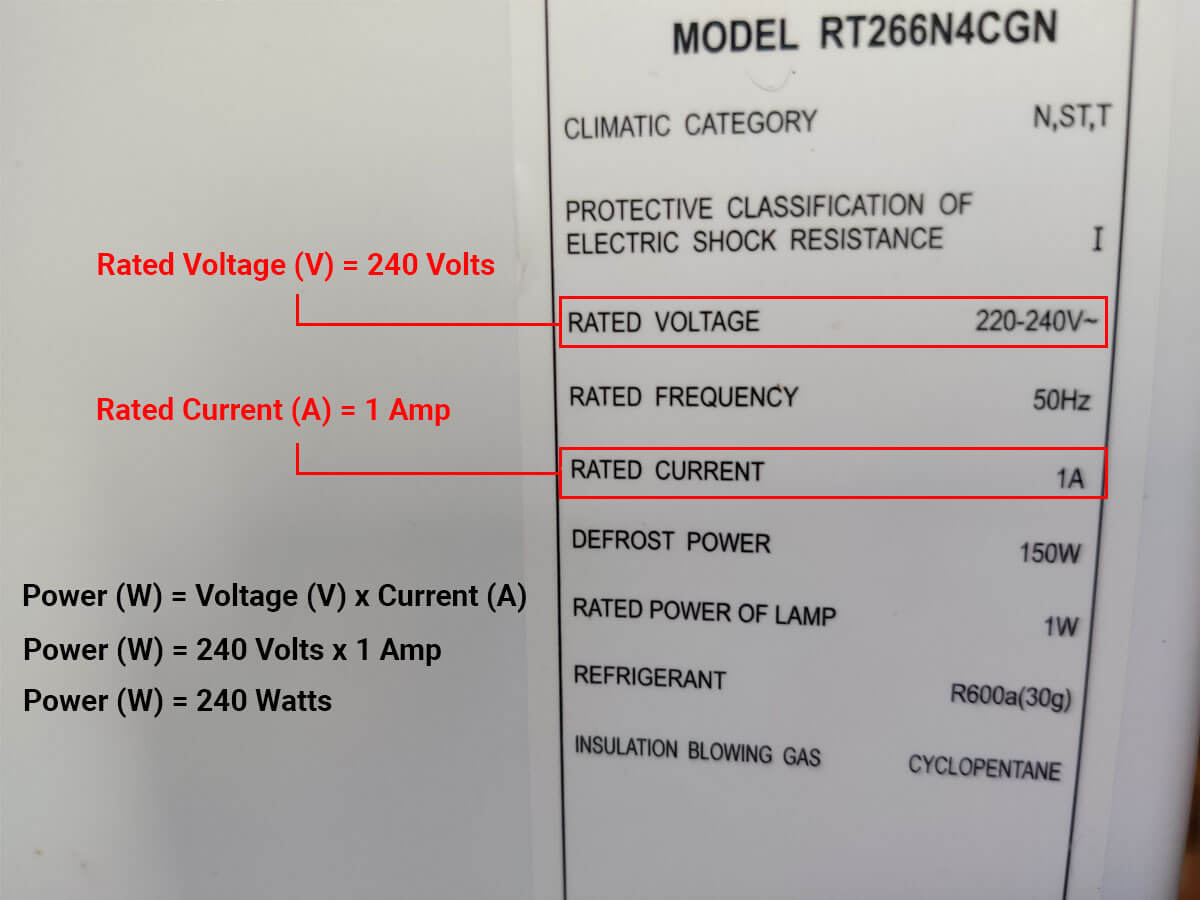
You can see that the manufacturer specifies 240 Volts as the Rated Voltage of the fridge and 1 Amp as its Rated Current. Using these 2 ratings, we can then calculate the Rated Power of the refrigerator as follows:
Rated Power (Watts) = Rated Voltage (V) x Rated Current (A)
Rated Power (Watts) = 240 Volts x 1 Amp
Rated Power (Watts) = 240 Watts
For this particular refrigerator, the inverter needs to have a Continuous Power rating greater than 240 Watts.
Now, as mentioned earlier, if you’re planning to run other appliances on the same inverter, you need to consider the wattage of those appliances.
For example, let’s say that in addition to this refrigerator, I had the following appliances that I want the inverter to be able to run simultaneously:
- 2 LED lightbulbs rated at 20 Watts each
- A laptop charger rated at 60 Watts
- A TV rated at 50 Watts
Adding up the power usage of all these appliances running together with the refrigerator, the total would be:
Total Power Usage (Watts) = 240 Watts (fridge) + 40 Watts (lights) + 60 Watts (laptop charger) + 50 Watts (TV)
Total Power Usage (Watts) = 390 Watts
So, the inverter I use should have a Continuous Power Rating greater than 390 Watts.
What is the surge power of your refrigerator?
The main component inside your refrigerator responsible for the cooling, as well as all the fridge’s power usage, is the compressor. However, even though your fridge stays plugged in around the clock, the compressor doesn’t operate continuously; it cycles ON and OFF in a way that maintains the internal temperature.
When the compressor kicks back in, it will briefly require a relatively high amount of current (amps) to gain momentum, which causes a surge in power usage.
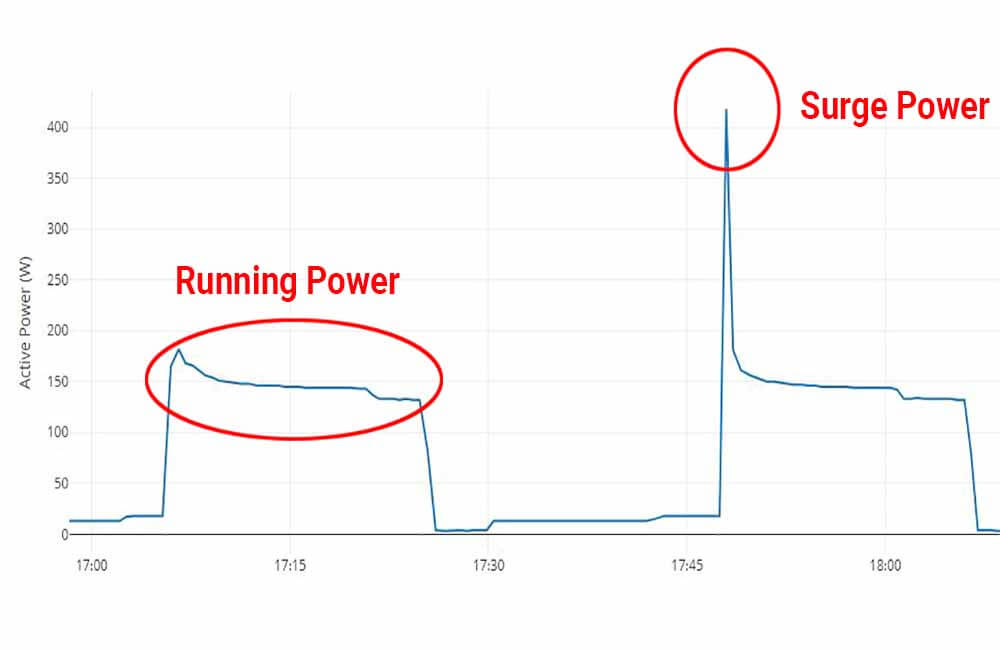
As mentioned earlier, this “Starting Wattage” can occasionally be up to 6 times the rated “Running Wattage” of the refrigerator.
Even though this surge in power usage typically lasts only a fraction of a second, if the inverter lacks sufficient Surge Power capacity, it might trip, causing your refrigerator to shut off.
To properly size your inverter, you should calculate the “Potential Starting Wattage” of your refrigerator and ensure that the Surge Power rating of the inverter is greater than that.
But, how do you determine this “Potential Starting Wattage”?
Manufacturers typically don’t specify the surge wattage (or current) on the refrigerator’s specification label/sticker. However, a straightforward way to approach this is to multiply the power rating of your refrigerator by 6.
For instance, my refrigerator has a Rated Power of 240 Watts, so, its potential starting wattage can be calculated as follows:
Potential Starting Wattage (Watts) = Rated Power (Watts) x 6
Potential Starting Wattage (Watts) = 240 Watts x 6
Potential Starting Wattage (Watts) = 1440 Watts
So, for my refrigerator to operate reliably, the inverter should boast a Surge Power rating exceeding 1440 Watts. But if I also plan to run extra appliances, I need to factor in their power usage.
Let’s stick to the previous example:
- 2 LED lightbulbs rated at 20 Watts each
- A laptop charger rated at 60 Watts
- A TV rated at 50 Watts
For the inverter to reliably run the refrigerator and these additional appliances, it must have a Surge Power rating greater than 1590 Watts:
Potential Surge Wattage (Watts) = 1440 Watts (refrigerator) + 40 Watts (lights) + 60 Watts (laptop charger) + 50 Watts (TV)
Potential Surge Wattage (Watts) = 1590 Watts
Now, if you want an even more accurate way to determine the Potential Starting Wattage of your refrigerator, look for the Locked Rotor Amps (LRA) specified on the compressor.
Locked Rotor Amps – or LRA for short – refers to the maximum amount of current that the motor inside the compressor may require to start. This value is not usually printed on the refrigerator’s specification sticker but on the specification sticker on the compressor itself.
The compressor can be found on the back of the refrigerator.
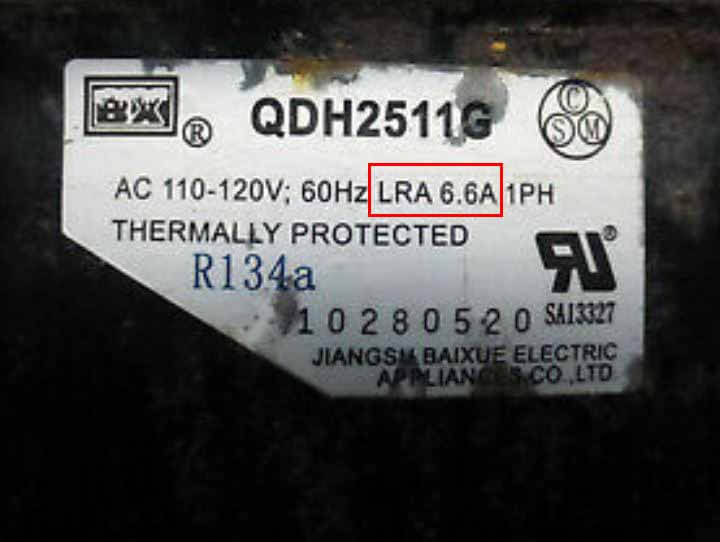
The LRA can be used to calculate the potential Surge Power of the refrigerator. For example, the potential surge power of the compressor from the image above is calculated as such:
Surge Wattage (Watts) = LRA (A) x Voltage (V)
Surge Wattage (Watts) = 6.6 A x 120 V
Surge Wattage (Watts) = 792 W
Assuming the running wattage of this fridge is less than 500W (which is surely the case), an inverter such as the BESTEK 500W Power Inverter would be a perfect match. It’s rated at 500 Watts and has a 1000W peak power capacity, and it’s a Pure Sine Wave inverter.
Related Topics:
How much solar power do I need to run a refrigerator?
What size battery do I need to run a refrigerator?
How long can a 12V battery run a refrigerator?










What a great explanation thank you. Clear and precise.
Thanks for the explanation, it really helps me alot.
Thanx for the explanation Younes
I just added this site to my google reader, great stuff. Can not get enough!
Thank you Younes. Simple and straightforward!
Thank you
Nice and clear right up, which was very helpful.
Are fridge freezers less efficient on 120v than 240v? As my “A” rating, Beko FR uses 75w when running and 165w defrosting, and it’s 460lt (16.24CF) but i’m glad I saw this, so I tested a full start up, by fully defrosting it overnight and for the first minute when turning it back on it used 950w, I was planing to buy a 600/1200w SW inverter, but now I know I need to go much bigger.
Thanks again Aaron.
Very helpful. Thank you!!!
Unfortunately this didn’t help because I can’t get the numbers off of the compressor and my label is not as detail oriented as the example that you gave. For novice the explanation needs to be simplified.
All the explanation did was make me afraid to now get anything to keep my refrigerator running in case of a power outage
As mentioned above, a 1500W should be able to power most refrigerators. However, if you want to be 100% sure and can’t locate the LRA on your compressor, you can use an electricity monitoring device, such as the kill-A-Watt meter.
Plug the electricity meter into the outlet, plug your fridge into the meter, turn on the fridge, and look at the maximum amount of watts it uses when it kicks off.
Hope this helps.
Thank You so much!
Hi, thank you very mjch for the clear and understandable explanation and information.
Ben
Thanks a lot for this really informative piece. It has not only helped me determine the type of refrigerator to buy for my 2KVa Pure Sine Wave inverter, but also given me the knowledge of what to look out for when buying any appliances to be used on the inverter.
Thanks ????
Thanks for being precise, it makes the info clear. Many skip over details the average person doesn’t have knowledge of.